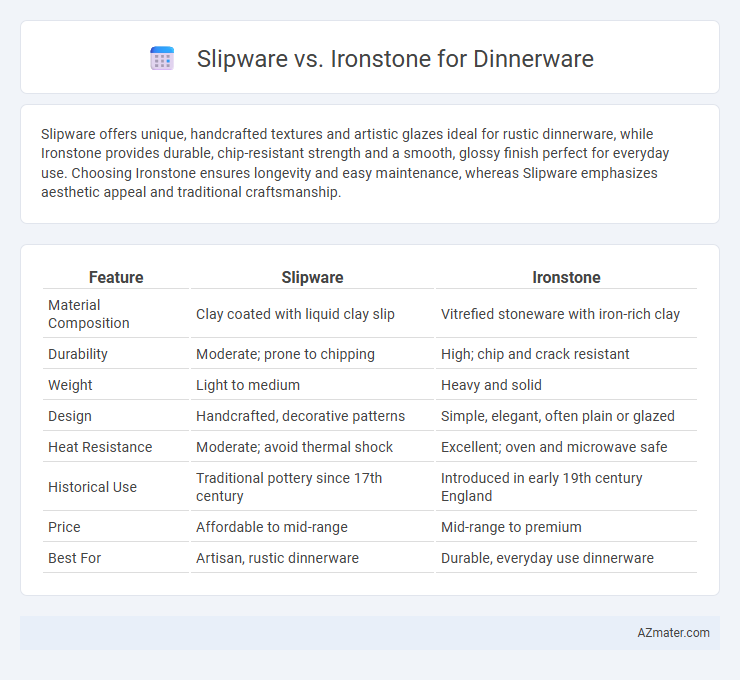Slipware offers unique, handcrafted textures and artistic glazes ideal for rustic dinnerware, while Ironstone provides durable, chip-resistant strength and a smooth, glossy finish perfect for everyday use. Choosing Ironstone ensures longevity and easy maintenance, whereas Slipware emphasizes aesthetic appeal and traditional craftsmanship.
Table of Comparison
| Feature | Slipware | Ironstone |
|---|---|---|
| Material Composition | Clay coated with liquid clay slip | Vitrefied stoneware with iron-rich clay |
| Durability | Moderate; prone to chipping | High; chip and crack resistant |
| Weight | Light to medium | Heavy and solid |
| Design | Handcrafted, decorative patterns | Simple, elegant, often plain or glazed |
| Heat Resistance | Moderate; avoid thermal shock | Excellent; oven and microwave safe |
| Historical Use | Traditional pottery since 17th century | Introduced in early 19th century England |
| Price | Affordable to mid-range | Mid-range to premium |
| Best For | Artisan, rustic dinnerware | Durable, everyday use dinnerware |
Introduction to Slipware and Ironstone
Slipware is a type of pottery characterized by its decorative use of liquid clay slip, often featuring vibrant, hand-painted designs that add unique artistry to dinnerware. Ironstone, developed in the early 19th century, is a durable, dense ceramic known for its strength and glossy finish, making it ideal for everyday use. Both materials offer distinct aesthetic and functional qualities, with slipware prized for its rustic charm and Ironstone valued for its resilience and classic appearance.
Historical Origins and Development
Slipware originated in the medieval period, characterized by its decorative slip coating made from liquid clay, primarily developed in England and later spread across Europe and the American colonies. Ironstone emerged in the early 19th century as a durable, mass-produced alternative to porcelain, pioneered by English potter Charles James Mason, combining strength and affordability for everyday use. The historical development of slipware reflects artisanal craftsmanship and decorative techniques, while ironstone represents industrial innovation and the democratization of fine dinnerware.
Material Composition and Production Methods
Slipware dinnerware is crafted by applying a liquid clay mixture, known as slip, onto a pottery body before firing, resulting in unique decorative textures and patterns. Ironstone, an iron-rich feldspathic ware, undergoes high-temperature firing which produces a dense, durable, and non-porous surface ideal for heavy use. The contrasting material compositions--slipware's clay-based slip overlay versus ironstone's vitrified stoneware body--significantly influence their production methods and functional properties in dinnerware applications.
Distinctive Aesthetic Features
Slipware dinnerware showcases a rich, handcrafted aesthetic with intricate patterns created by swirling liquid clay (slip) on the surface, resulting in unique, organic designs that highlight artistic craftsmanship. Ironstone dinnerware features a smooth, glossy finish with a dense, durable composition, often exhibiting classic Victorian motifs and clean, elegant lines that emphasize its practical yet refined appeal. The distinctive visual contrast between Slipware's textured, earthy charm and Ironstone's polished, robust appearance defines their unique decorative identities in tableware collections.
Durability and Everyday Use
Slipware offers charming, handcrafted designs but tends to be less durable due to its porous clay body and slip coating, making it more prone to chips and cracks under frequent use. Ironstone dinnerware, made from dense, vitrified stoneware, provides superior durability and resistance to chipping, ideal for everyday use and heavy handling. Its non-porous surface also ensures easy maintenance and long-lasting performance in busy kitchens.
Popular Styles and Patterns
Slipware dinnerware showcases rustic, hand-crafted designs featuring earthy tones and intricate floral or geometric patterns, popular in traditional and farmhouse-style table settings. Ironstone is renowned for its durable, glossy white finish often adorned with transfer-printed blue or multicolor motifs, reflecting classic Victorian and vintage farmhouse aesthetics. Both styles offer a rich history and distinctive look, with slipware appealing to artisanal collectors and ironstone favored for its timeless elegance and practical strength.
Maintenance and Care Requirements
Slipware requires gentle cleaning with mild soap and water to avoid damaging its decorative slip coating, and it should not be exposed to sudden temperature changes to prevent cracking. Ironstone is more durable and dishwasher-safe, resistant to chipping and staining, making it easier to maintain for everyday use. Both materials benefit from hand washing to preserve their finish, but Ironstone's robust composition offers greater longevity with less careful handling.
Collectibility and Market Value
Slipware dinnerware offers unique hand-painted or slip-trailed designs that appeal to collectors seeking artisanal craftsmanship and historical significance, often increasing its market value in niche antique markets. Ironstone, known for its durability and classic white glaze, attracts collectors interested in mass-produced 19th-century American and English pottery, with pieces from renowned manufacturers commanding higher prices. Collectibility of slipware generally thrives on rarity and artistic detail, while ironstone's value is driven by brand reputation and condition, influencing their respective market demand and resale potential.
Environmental Impact and Sustainability
Slipware dinnerware is often handmade using natural clay and mineral-based glazes, making it a more environmentally friendly choice due to its biodegradable nature and lower energy consumption during firing compared to mass-produced ceramics. Ironstone dinnerware, typically made from refined clay and fired at higher temperatures, tends to have a longer lifespan but requires more energy-intensive manufacturing processes, leading to a larger carbon footprint. Choosing slipware supports sustainable craftsmanship with reduced emissions, while ironstone's durability can minimize replacement frequency, offering different environmental benefits depending on usage and production scale.
Choosing the Right Dinnerware for Your Home
Slipware offers unique, handcrafted designs with colorful glazes and a rustic appeal, ideal for those seeking artistic, one-of-a-kind dinnerware that complements eclectic or traditional decor. Ironstone provides durable, chip-resistant dinnerware with a smooth, glossy finish, perfect for families needing practical, long-lasting pieces suitable for everyday use. Selecting between slipware and ironstone depends on your preference for artistic expression versus durability and ease of maintenance in your home dining experience.

Infographic: Slipware vs Ironstone for Dinnerware
 azmater.com
azmater.com